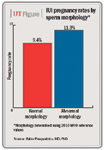Article
Intrauterine insemination success not predicted by sperm morphology
Results of a retrospective study identify several factors associated with success in achieving pregnancy after intrauterine insemination (IUI), but normal sperm morphology is not among them.
São Paulo, Brazil-Results of a retrospective study identify several factors associated with success in achieving pregnancy after intrauterine insemination (IUI), but normal sperm morphology is not among them, according to Brazilian researchers.
The study included data from the first IUI cycle performed using the father's fresh sperm in 300 couples. The procedures were done at the Assisted Fertilization Center, São Paulo, Brazil, for indications that included cervical infertility, relative male factor infertility, anovulation, or unexplained infertility. The procedures were performed between 2008 and December 2010, and normal sperm morphology was adjusted to World Health Organization (WHO) guidelines issued in 2010 (fifth edition of the WHO Laboratory Manual for the Examination and Processing of Human Semen). According to the recent guidelines, semen samples are considered normal if at least 4% of the sperm have normal morphology; 1999 criteria required normal morphology in at least 14% of sperm.
For the entire population, the overall pregnancy rate was 12.3%. Using the 2010 WHO criteria to categorize sperm morphology, the pregnancy rate was not significantly different comparing couples with normal versus abnormal sperm morphology (9.4% vs. 11.3%); the pregnancy rates were also not significantly different among couples with normal versus abnormal sperm morphology categorized using the previous reference values (9.8% vs. 11.6%).

"About 16% of prospective parents seek medical advice for infertility, and so it is of pivotal importance to identify which couples are likely to benefit from artificial insemination or in vitro fertilization techniques. Currently, however, no prognostic variables have been identified that can be used to give specific couples reliable information on the likelihood of a successful ongoing pregnancy after IUI," Dr. Pasqualotto said.
"Since the WHO recently described lower reference limits for the number of morphologically normal sperm, we sought to assess the likelihood of IUI success as a function of sperm morphology according to these new criteria. The results of our analyses suggest that couples with the best probability of achieving pregnancy after IUI are those in which the woman is less than 35 years old, the inseminated motile sperm count is at least 1 million, and ovarian stimulation allows the recruitment of at least two follicles measuring more than 16 mm. However, even after the establishment of new reference values for semen parameters, sperm morphology does not seem to make a difference," Dr. Pasqualotto said of the results, which were presented at the 2011 AUA annual meeting in Washington.
Data for the other variables showed the pregnancy rate was almost threefold higher among women aged 35 years and younger compared with their older counterparts (18.2% vs. 6.5%; p=.017) and more than 3.5-fold higher among women who had two or more preovulatory follicles >16 mm on the day of human chorionic gonadotropin administration compared with those having only one such preovulatory follicle present (18.6% vs. 5.2%; p=.011).
There was no statistically significant difference in the mean total number of inseminated sperm comparing couples that did and did not achieve pregnancy (26.4 vs. 34.8) nor when comparing the two groups in terms of the mean number of inseminated motile sperm (22.3 vs. 27). However, couples where the number of inseminated motile sperm was at least 1 million had a nearly 1.5-fold greater likelihood of pregnancy success compared with those having a lower number.
Newsletter
Stay current with the latest urology news and practice-changing insights — sign up now for the essential updates every urologist needs.















